Index


Review: Affordable board with good overclock
(This review is also avaiable in German.)
Today we check out the first Gigabyte board in our labs. Gigabyte sent us a combo board, which can handle four slots of DDR2 memory and only two slots with DDR3. If you think this will be future-proof you will be disappointed, because Intel is moving the memory controller into the CPU for the next generation, so all G. P, X 35/38/45/48 boards will be rendered useless with the next Intel CPU generation.
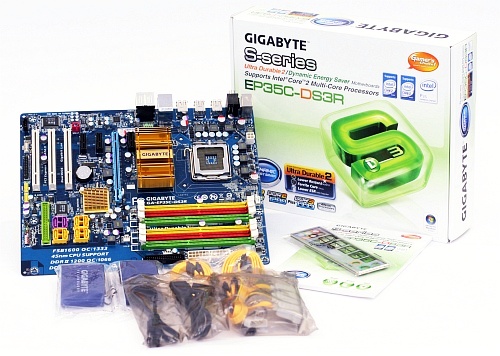
Features:
Intel P35/iCH9R
6-phase VRM
Realtek ALC889A
Realtek RTL8111B
JMB363 SATA II RAID 0, 1/IDE controller
ITE IT8718F-S super I/O controller
ICS9LPRS918HKL clock generator
passive cooling of chipsets/VRM
8Mb BIOS, version F3b
Mainboard Revision: 2.1
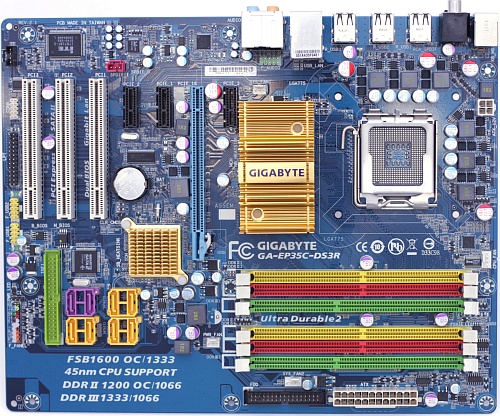
Slots:
1x PCIe 2.0 x16
3x PCIe x1
3x PCI
Memory:
2x Dual-Channel DDR2-slots for PC2-6400U memory up to 8GB
1x Dual-Channel DDR3-slots for PC3-8500U memory up to 4GB
Storage:
6-Port SATA II featuring RAID 0, 1, 5, 0+1, JBOD
1-Port IDE
2-Port eSATA II RAID 0,1, 0+1, JBOD
Backpanel ports:
1x PS/2 keyboard
1x PS/2 mouse
1x Gb LAN
8x USB 2.0
7.1 analog output
1x SP/DIF digital out
1x SP/DIF coaxial out

Accessories:
4x SATA cable (2 angeled 90°)
1x eSATA bracket with 2x eSATA & 1x HDD power
1x eSATA cable
1x HDD power of SATA power
1x Floppy cable
1x IDE cable
BIOS features:
Bus Speeds: Auto, 200MHz to 700MHz in 1MHz increments
Memory Ratios: Auto, fixed ratios: 1:1, 1:1.2, 1:1.25, 1.50, 1.60, 1.66, 1:2 depending on FSB/strap
FSB Strap: hidden, linked with Memory Ratio, 200MHz, 266MHz, 333MHz, 400MHz
DRAM command rate: Auto, 1T, 2T
DRAM timing control: Auto, manual
PCIe Frequency: Auto, 90 to 150 MHz in 1MHz increments
CPU Clock Multiplier: Auto, manual
Core 2 Duo: 6x-11x in 0.5x increments - Core-2 Duo, downwards unlocked
Core 2 Extreme: 6x-16X, downwards unlocked
CPU Voltage: auto, 0.9000V to 1.6000V in 0.00625V increments, 1.80V, 2.00V
CPU PLL Voltage: Auto, 1.50V to 2.78V in 0.02V increments D
DRAM OverVoltage: Auto, normal, +0.10V to +0.70V in 0.10V increments
DRAM DeOverVoltage: Auto, -0.10V
FSB Termination OverVoltage: Auto, normal, +0.10V to +0.30V in 0.10V increments
FSB Terminaton DeOverVoltage: Auto, -0.05V to -0.15V in 0.05V increments
Northbridge OverVoltage: Auto, normal, +0.10V to +0.30V in 0.10V increments
Northbridge DeOverVoltage: Auto, -0.10V
Testbed:
Motherboard:
Gigabyte GA-EP35C-DS3R (provided by Gigabyte)
Intel P35/iCH9R
CPU:
Intel Core-2 Duo E8400
CPU-Cooler:
Scythe Andy Samurai Master (provided by Scythe-Europe)
Memory:
Kingston 2GB Kit PC2-9600U KHX1200D2K2/2G (provided by Kingston)
CL5-5-5-15 CR2T at 1.80V
Patriot 2GB Kit PC3-10666U PDC32G1333LLK (provided by Patriot)
CL7-7-7-20-CR2T at 1.50V
Graphics Card:
Jetway Radeon HD3870 (provided by mec-electronics)
Power supply:
Silverstone Element SF50EF-Plus (provided by Silverstone)
Hard disk:
Western Digital WD4000KD (provided by Ditech)
Case fans:
SilenX iXtrema Pro 14dB(A) (provided by PC-Cooling.at)
Scythe DFS122512LS
Case:
Cooler Master Stacker 831 Lite (provided by Cooler Master)
Layout:
While the board is a full ATX design, much space has been left out for no reason. This combo board is a direct variation of the non-combo board, only extended with two more DDR3 slots. The audio header is located behind the Northbridge cooler, which is not a wise decision, because you need to route the cable across the board. Why Gigabyte only uses a 4-pin CPU-power-connector is beyond our understanding, because most of the PSUs come with an EPS-connector. If you have a PSU which does come with an EPS to P4 adapter cable it will add to the cable mess inside a case. Also, this board features lots of overclocking features, so an EPS connector would have helped, too.
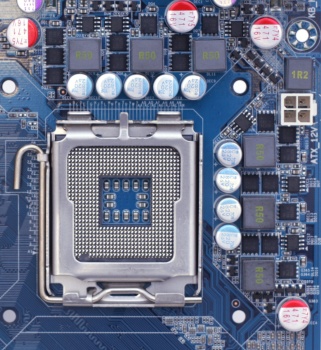
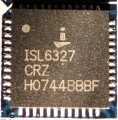
The VRM is an analog 6-phase design driven by an ISL6327, which is quite efficient. Forget about eight, ten, twelve phases, with the new 45nm CPUs there is no need for that. This board doesn't feature a heatpipe, so a big aluminum heatsink is keeping the temperature of the Northbridge in check. On the Southbridge a small aluminum heatsink does the same.
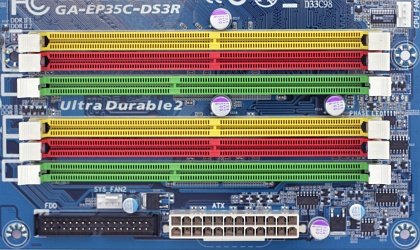
The memory slots are well placed. They are quite far away from the PCIe x16 slot, so you can change the memory with the graphics cards installed. The power-and floppy connectors are placed beneath.
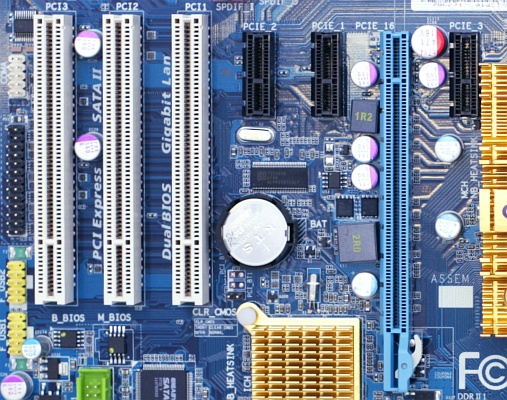
The slots are configured well, there is space behind the PCIe x16 slot, so you can buy one of the cards which features a passive cooler on the back of the graphics-card. There is no second PCIe x16 slot, so Crossfire is out of the question, but an HD3870X2 card will run fine. Three PCI slots give you plenty possibilities to use your old cards.
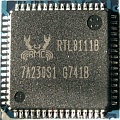
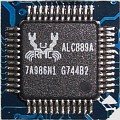
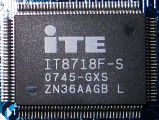
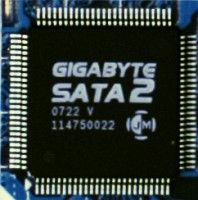
Network connectivity is provided by one Realtek RTL8111B chip. Realtek is not known for very good performance, especially the I/O load is quite weak. A Marvell, Broadcom or Intel chip would have suited better, but of course would also have increased costs. Audio is also provided by a Realtek chip: the ALC889A. We are not able to determine the difference between ALC888 and ALC889A, because the Realtek webpage doesn't know about it. The ITE chip is a super I/O controller, for all legacy devices, such as Floppy, LPT and COM ports. The so called "Gigabyte SATA2" chip is a JMicro JMB363.
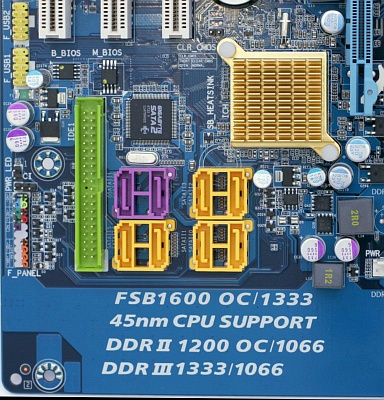
The SATA and PATA connectors are not on the edge of the board. Instead, Gigabyte decided to write some useless information on the unused space, instead to relocate the connectors. So the IDE connector is not placed well, a 90° relocation would have been more convenient. The better part is, you have plenty of SATA ports, so you can use up to eight SATA drives. If you plan to build a home-server, this board is definitive worth a thought. The board does not feature a power-LED, only the six phases have LEDs which will light up during booting, but you haven't any other diagnostic capabilities onboard. The front-panel-header is standard Gigabyte colored, so it's quite easy to correctly connect the front-panel.
BIOS:
Gigabyte is using a plain AWARD 1MB BIOS. We are not sure if the VCore detection is correct with the new E8400 CPU, but you can under-voltage it. For some reason Gigabyte is hiding some BIOS settings, which you can unlock with CTRL-F1. Default settings are quite strange. with COM1 and LPT enabled, even if Gigabyte does not provide the proper slot-brackets. Also to have "overvoltage" and "deovervoltage" settings is quite stupid. Does this mean I can overvoltage +0.30V and deovervoltage -0.05V to get +0.25V, or does it mean one is overriding the other? This is only confusing the user, one setting with much finer settings would have been the wiser choice.
FSB-Overclocking:
The EP35C-DS3R did very well. It reached 530MHz, which is quite an achivement.
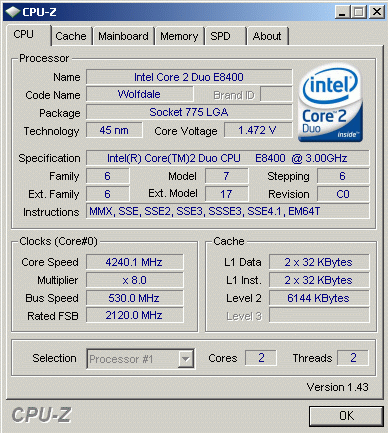
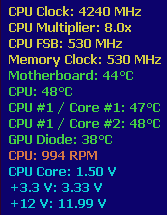
CPU-overclocking:
It was not difficult to reach 4.40GHz. We set the VCore to 1.6000V but as you can see, the VCore dropped to 1.5360V. We know the sensors are not very exact, but the VRM fails to keep the current stable within 0.0500V, which is specified by Intel. The BIOS does not provide a "loadline calibration," so you can't manually set the VRM to act more stable.
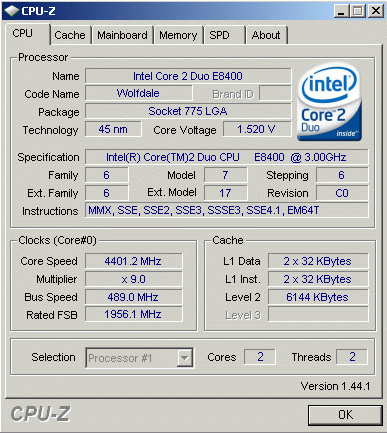

Memory-overclocking:
Gigabyte hasn't got the best reputation when it comes to memory overclocking. It is also expected that combo boards can't do much memory overclocking. With DDR2 we hit the wall at about 1150MHz. You may boot with 1200MHz, but even lowering the timings it was not possible to run the board stable. We don't care that much, because higher memory frequencies doesn't mean speed improvements at all. With DDR3 we could easily achieve 1333MHz, 1600MHz was not possible. You can expect stable operation up to 1450MHz.
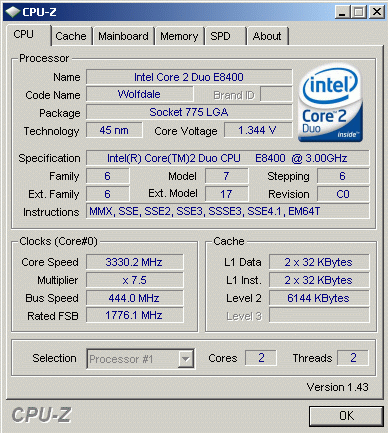
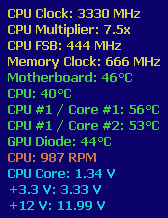
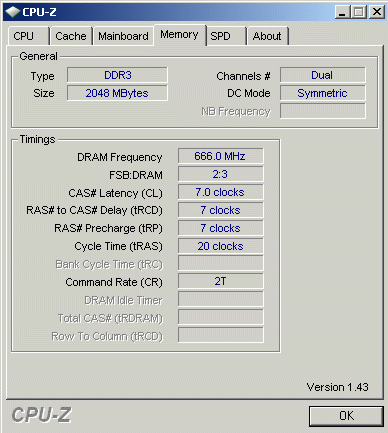
FSB BIOS clocking:
We have to state that we always recalculate the bench results to nominal frequencies. Most vendors do an overclock to their products, maybe to get more bench points, but we nullify such attempts. The Gigabyte is quite close to the nominal speeds:
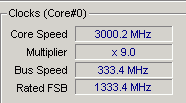
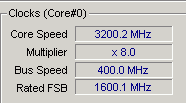

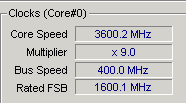
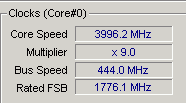
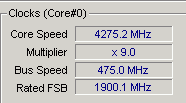
Benchmarks:
Please note that different bios revisions may give different results. All benches are done with AUTO settings without altering any BIOS option besides CPU VCore, NB VCore and FSB Termination Voltage.
x264:
x264 is a h.264/AVC codec which supports four threads, and it's available for free. We took a PAL episode of "Babylon 5" with a length of 41 minutes, 57 seconds and 8 frames. We tried to "emulate" the most common usage when you encode your movies:
1st: We have a perfect master, so we only de-interlace the content and resize it without any other manipulations; we marked this as "fast."
2nd: You get bad mastering on many DVDs, especially "old" stuff or when the studios are in a hurry for the release. In this case you want to improve the picture quality, which is done by filtering the content. You can choose from lots of filters for any purposes you can think of, but we only used the most common "undot," "FluxSmooth" and "MSharpen." Of course, we also de-interlaced, filters were done before any resizing took place (which is slower). We marked this as "slow."
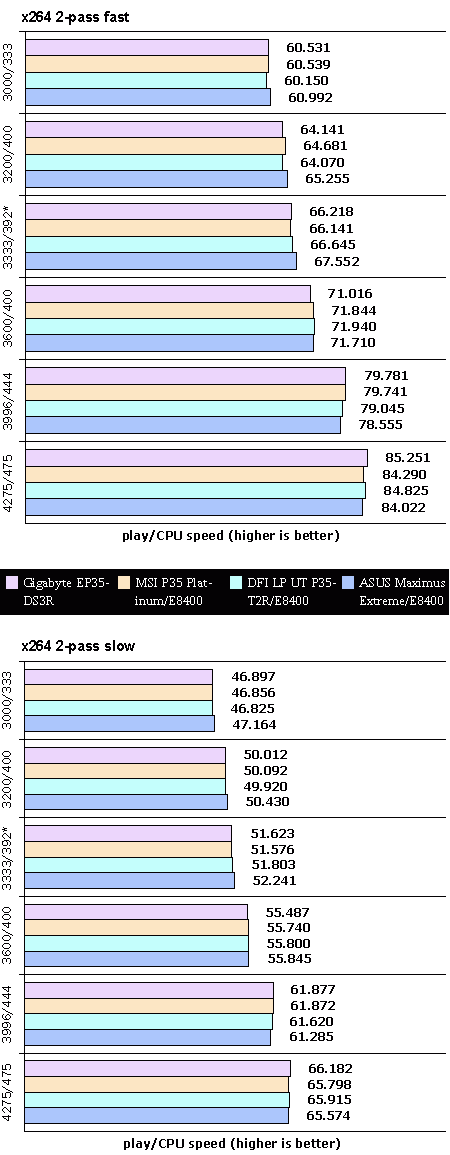
Note: The DFI P35 mainboard doesn't support half multipliers, so it was using 417x8.
LameMT:
The same episode we encoded, we used for our MP3-testing. We don't recommend using MP3 for encoding, because AC3 can do the job better, but nearly 42 minutes gives us approximately the length of any given album.
A measurement in seconds, as many sites do, is useless, because the differences are too small. So we used the built-in play/CPU ratio, this means the CPU is encoding x-times faster then the track-length. Fast memory does not play an important role here. For your convenience we also show the single-threaded benchmarks figures, they can be re-produced with any version of L.A.M.E. Only LameMT can do multi-thread and take advantage of multi-core processors.
We used this setting: lamemt --vbr-new -q 2 -V 2 -m j --strictly-enforce-ISO --resample 48
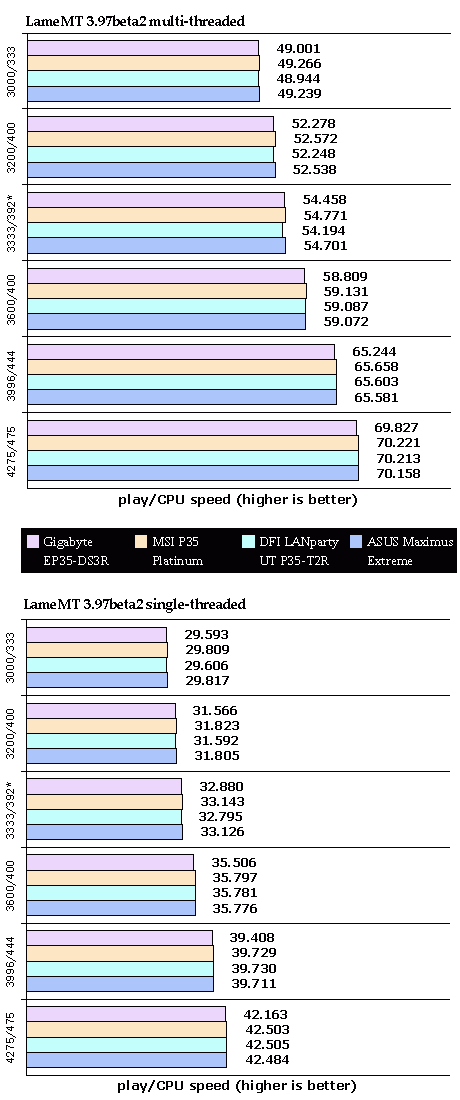
Note: The DFI P35 mainboard doesn't support half multipliers, so it was using 417x8.
Power-Consumption:
As expected, the board does very well. Even with an quite standard VRM, the power-consumption stays quite low. Overclocking the board in more extreme regions the VRM goes more inefficient in idle mode. Under load the VRM keeps efficient and is quite comparable with the MSI P35 four-phase VRM.
Please note that other configurations may yield other results.
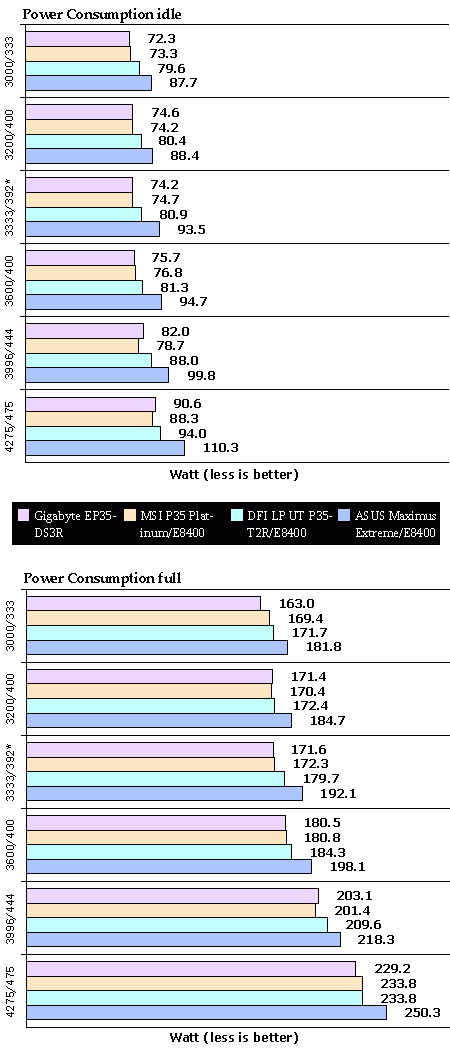
Conclusion
Gigabyte did a good job. While overclocking and power-consumption yields good results; the layout is another story. If you get a full ATX board they would have plenty of space to use them for good. There are no issues with the performance as well, it's quite on the same level as others.
This board is not a budget board and it's not a high-end board, either. For about €95,- you get a fine board and if you can live with the weak layout, we can't speak against it. The DDR2 only board is not cheaper, but may yield better results with memory overclocking. We prefer full ATX boards compared to 2/3 ATX board due to better mounting inside the case.
We look forward to more Gigabyte boards in our labs in the future.
